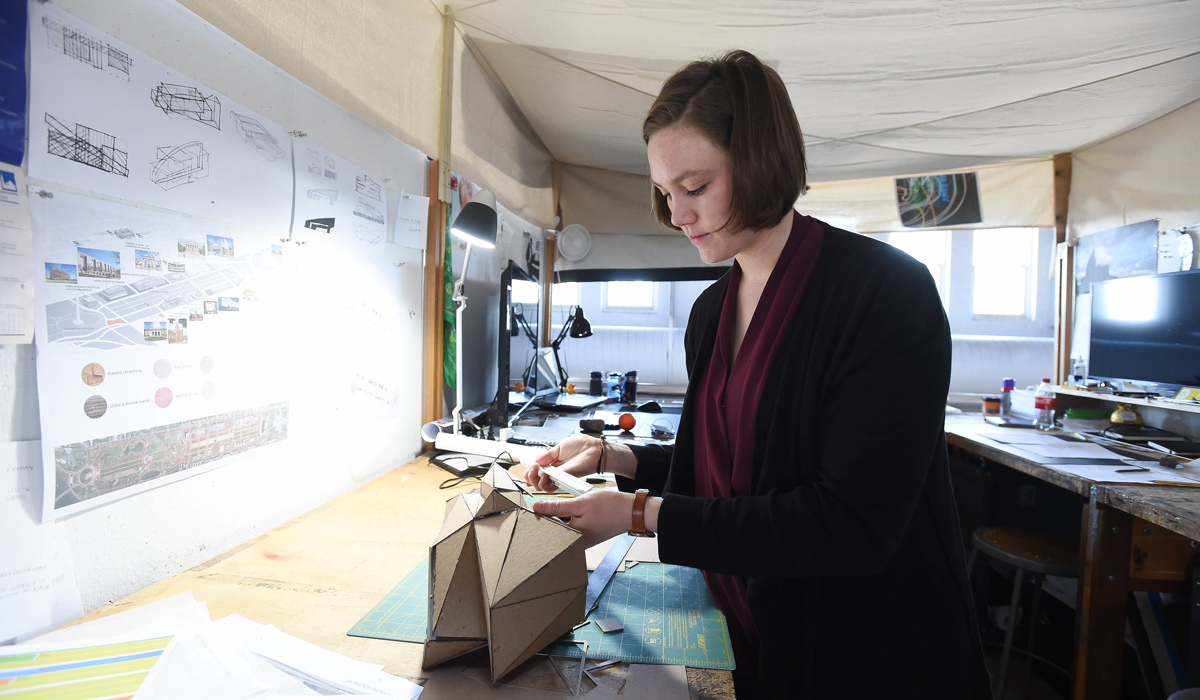

On any given day, senior Tatiana Amundsen, an architecture major from Seattle, Wash., is not hard to locate. She almost always can be found working on sketches or designs at her desk in the Edward M. Crough Center for Architectural Studies.
“If I’m not in class, I’m here,” she said. “I can’t imagine a better environment to work.”
This semester, Amundsen and a team of three friends are working together on their senior project: designs for an imaginary presidents’ museum on the National Mall. The project, which must be done by May, is a complicated one. The team must decide how their museum will look next to other Smithsonian museums nearby. They must plan out mechanical, plumbing, and electrical systems. And they must prepare detailed sketches and models to neatly and accurately depict each step along the way.
“Our building is going to go right across from the African American History Museum,” said Amundsen. “We’re trying to get across the idea that we’re not capping the Mall, but that we’re projecting back to [the] Lincoln [Memorial]. It’s always a challenge to see if we can make that happen.”
Over the past four years, Amundsen says she’s grown accustomed to spending long hours working in the Crough Center. Like other architecture students, she’s had a desk in the building since her first studio class her freshman year. She thinks the building’s open-air layout fosters a sense of community in the school, allowing students to work together and seek advice on difficult projects.
“I just really like the whole studio atmosphere, the fact that everybody is always there and that we get help from each other,” she said. “It really is its own culture.”
“We have a culture where our desks are open and we can just walk over to the next one and ask them for their opinion or advice.”
Architecture Dean Randall Ott notices that collaborative mindset as well. He believes one of the greatest strengths of the School of Architecture and Planning is its “vibrant studio culture.”
“It’s a culture of making, a culture of creativity,” he said. “It’s often said that the lights never go off in the Crough Center and that is true. It’s the only academic facility on campus that’s open and available to students 24-7 and where students are given a dedicated space to work every semester.”
Since architecture is a very “self-directed field,” Ott said students often end up dedicating long hours to their projects.
“Studying architecture is a personal quest and a labor of love,” he said. “You can never say the design project is done; it’s just a question of what your intentions are and what you feel you have achieved. So students become incredibly wrapped up in their work where it’s very clear they’re no longer just driving for some kind of grade. They’re really driving to do the most extraordinary project they can.”
Amundsen knows all about that drive for excellence. When she arrived at Catholic University four years ago, she said she knew almost nothing about architecture. One of her biggest challenges was learning how to draw designs during her sophomore studio.
Over time, Amundsen said she has gained confidence in her own skills through hours of practice, as well as discussions with professors and classmates. During her junior year, she spent a semester abroad learning about the architecture in Rome. And this fall, she studied alongside graduate students in the school’s Walton Studio, which featured lectures by the world-renowned Indian architect Prem Chandavarkar.
“I think it helps when you realize that the other students really do want to help each other,” she said. “We have a culture where our desks are open and we can just walk over to the next one and ask them for their opinion or advice.
“Architecture is all about persistence,” she said. “You can do the wrong thing 500 times, but when you get that one thing that might be right, your professor is going to pull it out for you. You just have to stick with it and not give up.”